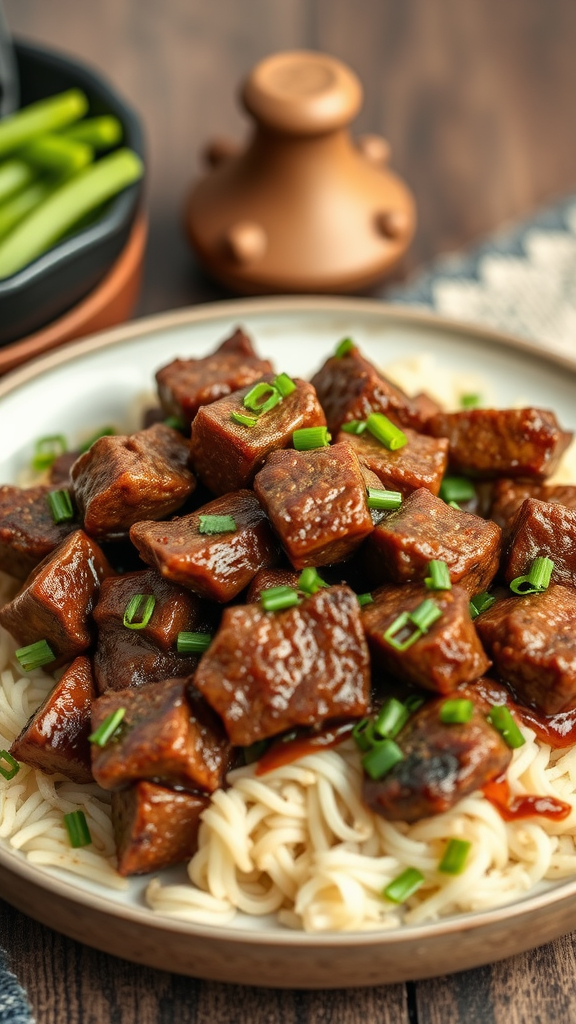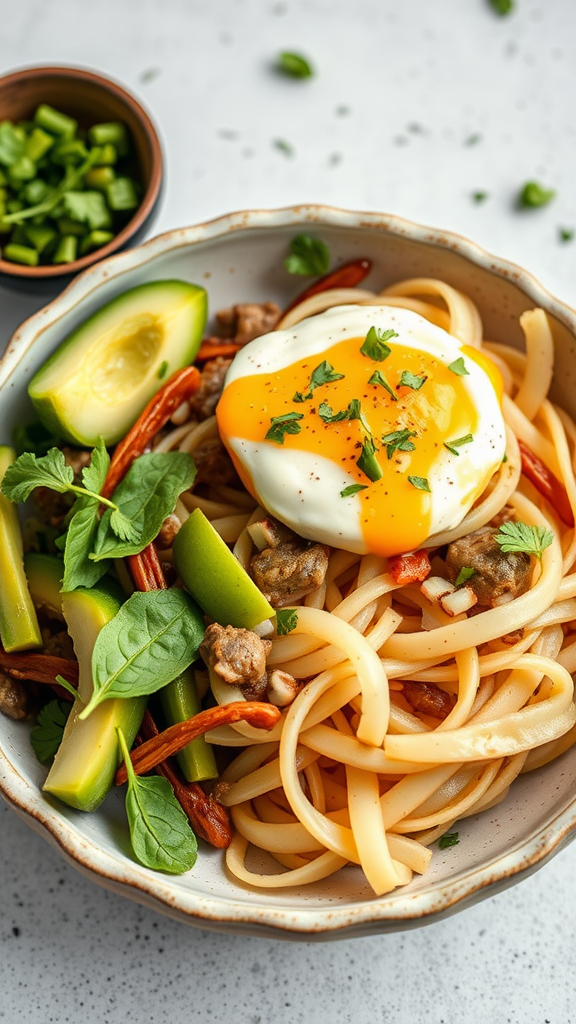Exploring the Health Benefits of a Mongolian Beef Recipe in a Paleo Diet
Mongolian beef is a delightful dish that can tantalize your taste buds while supporting a healthy lifestyle, especially if you follow a Paleo diet. The sweetness of this dish comes from soy sauce and sugar, but in a Paleo-friendly version, you can swap these ingredients for fantastic alternatives. This not only makes the dish suitable for your diet but also enhances its health benefits.
One of the core tenets of the Paleo diet is to consume foods that align with what our ancestors ate. This includes meats, vegetables, fruits, nuts, and seeds, while avoiding processed foods. All these elements reflect beautifully in a Mongolian beef recipe tailored for those adhering to Paleo principles. Let’s explore the reasons this dish can be a healthy addition to your Paleo journey.
Quality Source of Protein
Beef is an outstanding source of protein, which is essential for building and repairing body tissues. Choosing grass-fed beef elevates this benefit even further. Grass-fed beef is richer in omega-3 fatty acids, which have been linked to heart health. By incorporating lean cuts of beef in your Mongolian beef recipe, you ensure you’re fueling your body with high-quality proteins.
Rich in Nutrients
- Iron: Beef is known for its high iron content, which is vital for energy production and oxygen transport in the body.
- Vitamin B12: This vitamin is essential for red blood cell formation and brain function.
- Zinc: This mineral supports your immune system and helps in wound healing.
Using fresh vegetables, such as bell peppers and broccoli, in your recipe not only adds color but also increases the dish’s nutrient profile. Vegetables provide fibers, vitamins, and minerals that further enhance the dish’s healthiness. The combination of beef and veggies is not just delicious; it’s food for your mind and body!
Lower Glycemic Options
The typical Mongolian beef recipe includes soy sauce and sugar, which can spike your blood sugar levels. In a Paleo version, instead of soy sauce, opt for coconut aminos. This substitute has a much lower glycemic index and contains amino acids beneficial for muscle recovery. You can also use a natural sweetener like honey or maple syrup in moderation, which mimics the sweetness without too much impact on blood sugar levels.
Maintaining a Healthy Weight
A lower carbohydrate intake plays a significant role in weight management. When you customize your Mongolian beef recipe with fresh veggies and omit sugars, you create a dish that is low in carbs, high in healthy fats, and satisfying. This combination can keep you full longer, reducing cravings and aiding in weight loss or maintenance.
Healthy Cooking Methods
Stir-frying your Mongolian beef with healthy fats, such as coconut oil or avocado oil, enhances the flavor while keeping the dish Paleo-friendly. These oils are high in healthy fats that do not contribute to inflammation, in contrast to many processed oils. Choosing the right cooking method helps retain nutrients and flavor without sacrificing your dietary preferences.
A Versatile Dish
The great thing about a Mongolian beef recipe in a Paleo diet is its versatility. You can easily customize it based on the seasonal vegetables available or your personal tastes. This adaptability allows you to create a fresh meal every time, avoiding monotony in your diet.
By embracing a Mongolian beef recipe that adheres to Paleo principles, you set yourself up for a flavorful dining experience packed with nutritional benefits. Whether you’re a seasoned Paleo enthusiast or just exploring healthier eating habits, this dish is a wonderful addition to your meal plan. Enjoy the rich tastes and feel good about what you’re nourishing your body with!
Creative Variations for Paleo-Friendly Mongolian Beef Dishes
Mongolian beef is a beloved dish that traditionally features tender beef stir-fried with a savory sauce. If you’re following a paleo diet, you’ll be pleased to know that there are plenty of creative variations on this classic that keep it both tasty and compliant with paleo principles. Here are some unique takes on the traditional Mongolian beef recipe that you can easily whip up in your kitchen.
Beef and Bok Choy Stir-Fry
Instead of using typical vegetables, try adding bok choy for a fresh, crunchy texture. Bok choy is low in calories and packs a nutritional punch, making it an ideal fill-in for your paleo Mongolian beef.
- Ingredients:
- 1 lb flank steak, sliced thinly
- 2 cups bok choy, chopped
- 1/4 cup coconut aminos
- 2 garlic cloves, minced
- 1-inch piece of ginger, grated
- 1 tablespoon sesame oil
Simply stir-fry the beef until browned, then add the bok choy, garlic, and ginger. Drizzle with coconut aminos and sesame oil before serving. This variation is both delicious and quick to prepare!
Spicy Mongolian Beef Lettuce Wraps
If you’re looking for a fun way to serve your Mongolian beef, consider turning it into lettuce wraps. This offers a low-carb alternative that’s perfect for a gathering or a light meal.
- Ingredients:
- 1 lb ground beef
- 1 head of butter lettuce
- 1/4 cup coconut aminos
- 2 tablespoons chili paste
- 1/4 cup green onions, chopped
Cook the ground beef in a frying pan until fully browned, then stir in the coconut aminos and chili paste. Spoon the mixture into individual lettuce leaves and top with chopped green onions for a delightful, fresh presentation.
Mongolian Beef Zoodle Bowl
If you’re a fan of zoodles — zucchini noodles — this is a splendid way to transform the classic recipe into a nutrient-dense meal. The veggies make a perfect base for the succulent beef and savory sauce.
- Ingredients:
- 1 lb sirloin steak, thinly sliced
- 2 medium zucchinis, spiralized
- 1/4 cup coconut aminos
- 1 red bell pepper, sliced
- 2 tablespoons olive oil
Sauté the red bell pepper in olive oil, add the beef, and cook until it is just browned. Toss in the zoodles and coconut aminos for a quick toss just until the zucchini is tender. This dish is colorful, healthy, and fills you up without weighing you down.
Vegetarian Mongolian Beef Alternative
If you’re craving a meat-free option but still love the Mongolian flavors, consider using mushrooms and eggplant as your base. Both ingredients absorb flavors beautifully and provide a satisfying texture.
- Ingredients:
- 2 cups shiitake or portobello mushrooms, sliced
- 1 eggplant, cubed
- 1/4 cup coconut aminos
- 2 garlic cloves, minced
- 1 tablespoon sesame oil
Fry the mushrooms and eggplant in sesame oil until browned. Add in the garlic and coconut aminos. Stir until everything is well-coated and heated through. This vegetarian version still celebrates the Mongolian flavors you love while keeping it paleo-friendly.
Whether you stick to the traditional route or mix it up with these variations, Mongolian beef can easily be adapted to meet your paleo lifestyle. With the right ingredients and creativity, every meal can be both healthy and satisfying. Get ready to impress yourself and your loved ones with these delightful adaptations!
Conclusion
Embracing a Mongolian beef recipe within a Paleo diet offers a delicious way to enjoy flavors while prioritizing health. The health benefits of this dish are numerous, as it aligns with Paleo principles by using lean cuts of beef and fresh, wholesome ingredients. These choices provide essential nutrients, such as protein, vitamins, and minerals, which promote overall wellness. Moreover, eliminating processed sugars and grains from your meal enhances energy levels and supports balanced metabolism.
Exploring creative variations in your Mongolian beef dish can elevate your culinary experience. Whether you’re substituting traditional ingredients with zucchini noodles or experimenting with different vegetables like bell peppers and broccoli, you can make this dish uniquely yours without compromising on taste. Adding herbs and spices tailored to your preference can also introduce new dimensions to the flavor profile, keeping your meals exciting and satisfying.
Adopting a Paleo-friendly Mongolian beef recipe is not just about adhering to a diet; it’s about enjoying every bite while nourishing your body. With endless customization options, you can prepare this dish to fit your palate and dietary needs. So grab your ingredients and start cooking; you’ll find that this tasty twist on a classic meal is both fulfilling and supportive of your health goals. Enjoy the journey of preparing and tasting, as a great meal can bring joy and health benefits alike.





Leave a Reply